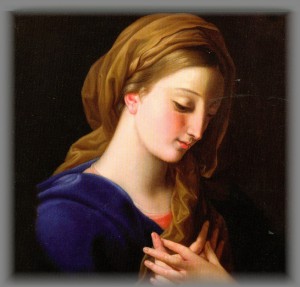 Who is ‘Mary’? As far as the gospels tell us she is the mother of Jesus. Nothing more is revealed about her; mother of Jesus is her identity. Interestingly most of the other women in the gospels are also called Mary too! This fact reminds me of how it is assumed that every Irishman’s name is Paddy or every Scotsman is called Jock, even after their true name has been given. It is as if their real name had no consequence – they have no consequence. Is this how women were viewed in Mary’s time? Apart from her motherhood, does this mean that Mary is a blank canvas upon whom the hopes and dreams (and fears) of the developing Christian Church are expressed?
Who is ‘Mary’? As far as the gospels tell us she is the mother of Jesus. Nothing more is revealed about her; mother of Jesus is her identity. Interestingly most of the other women in the gospels are also called Mary too! This fact reminds me of how it is assumed that every Irishman’s name is Paddy or every Scotsman is called Jock, even after their true name has been given. It is as if their real name had no consequence – they have no consequence. Is this how women were viewed in Mary’s time? Apart from her motherhood, does this mean that Mary is a blank canvas upon whom the hopes and dreams (and fears) of the developing Christian Church are expressed?
The early Church Fathers were ambivalent towards her. Certain of them including, St. John Chrysostom, St. Cyril of Alexandria, St. Basil, and Origen, held that Mary was not sinless. In fact St. John Chrysostom mentions that at the Wedding Feast of Cana she presumed to instruct Jesus (John 2:3-4) and Jesus calls her ‘woman’ which suggests distance in their relationship. Another scripture that challenged St. John Chrysostom was Mark 3:21, where Jesus’ relatives set out to seize him saying ‘he is out of his mind.’ In Mark 3:31-35, these relatives are described as ‘Your mother and your brothers and your sisters are outside asking for you’ and Jesus appears to reject his family saying as he looks at the crowd seated around him, ‘These are my mother and my brothers. Whoever does the will of God is my brother, and sister, and mother.’ In our present time, many Protestants do not share our belief in the perpetual virginity of Mary, the assumption of Mary into heaven and her immaculate conception; consequently they see a minimal role for Mary within Christianity, based on the brevity of biblical references. They do however accept the importance of her ‘fiat,’ her ‘yes’ to the angel at the Annunciation and, as such, see her as a model of a Christian’s response to God.
In an interesting development of the veneration of Mary, in the late 11th century the troubadours spread across medieval Europe. Ezra Pound wrote in his Canto VIII that William of Aquitaine ‘had brought the song up out of Spain with the singers and viels’. The form and the subject matter of their lyric poetry owed much to the Moors of Spain (Andalusian Muslims). William’s grand-daughter, Eleanor of Aquitaine turned her court at Poitiers into the center of troubadour activity. She was one of the wealthiest and most powerful women of her age and was married to Louis VII King of France. St. Bernard of Clairvaux, Louis VII’s principal advisor, was troubled by the rise of the troubadours and their Muslim origins. His solution was to ‘borrow’ the troubadour ideal of ‘courtly love’ and used it to emphasize religious and spiritual love, personal disinterestedness and mysticism. The knight’s devotion for the unapproachable high born lady, the focus of the knight’s quest for courtly love, morphed into devotion to Mary – Notre Dame (Our Lady). St. Bernard is credited as the originator of the Hail Mary, a prayer known and said to this day. Interestingly, St. Bernard, to whom Marian devotion owes so much, was the source of material for the troubadours as his teachings on Mary were used as inspiration for the romantic poetry which so influenced St. Francis of Assisi. The great Marian prayer of the Rosary dates from this time as does the rise of attention given to Marian apparitions.
The focus on Mary clearly satisfied a deep seated need amongst the faithful. God the Father is often seen as the male, distant, all powerful creator, Jesus Christ is also male and can take on the persona of a feudal king (distant, all powerful, judging), and the Holy Spirit is sexless. The feminine side of human nature was not represented within the Trinity. However both men and women need to seek out the tenderness and nurturing of the mothering side of God. Mary increasingly satisfied this need. In fact, Mary was so important prior to the reformation that Protestants (conscious that she does not appear much in scripture) reacted negatively to Mary in order to differentiate themselves from the ‘old religion’. While Catholics would say the Rosary during Mass because they didn’t understand Latin and the priest ‘said’ the Mass, dealing with God on their behalf. The Rosary and Mary were where their spiritual hearts lay. The Trinity was too distant: perfectly transcendent. Mary satisfied their yearning for the immanent God.

